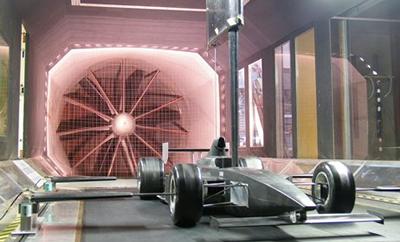The University of Southampton Wind Tunnels are able to offer top class and affordable facilities capable of accommodating anything from quick half day validation studies to extended research work on everything from aircraft wings to yachts, wind turbines to racing cars.

Anechoic Wind Tunnel
The new anechoic wind tunnel at the Boldrewood Campus is part of the National Wind Tunnel Facilities. It is a closed return, open jet wind tunnel. The nozzle dimensions are 1 m x 0.75 m and the maximum flow velocity is 80 m/s. The internal dimensions of the anechoic chamber are 8.1 m x 4.4 m x 5.5 m. The chamber is fitted with approximately 500 anechoic wedges giving a cut-off frequency is 250 Hz.
R. J. Mitchell wind tunnel
The R. J. Mitchell wind tunnel is a large and extensively equipped low-speed wind tunnel with a 3.6 m x 2.5 m (11'x 8') working section, with moving ground and a maximum wind speed of 40 m/s. It is ideally suited for vehicle aerodynamic work but is also equipped with a Nutem overhead 6-component balance, surface pressure scanning and PIV system for optical measurements of the airflow.
7' x 5' wind tunnel
The 7' x 5' wind tunnel has a slightly smaller 2.1 m x 1.5m working section, with wind speeds of up to 45 m/s, and is used extensively for undergraduate and postgraduate research projects. It also has a moving ground for ground-effect aerodynamic work. The tunnel also has a 4.6 m x 3.7 m (15' x 12') low speed section that is used for wind engineering studies and work for the marine industry on racing yacht sails.
3' x 2' tunnel
The 3' x 2' tunnel is an open circuit facility with a closed 0.9 m x 0.6 m x 4.5m working section. It is installed in a laboratory, is equipped with a 3D computer controlled probe traversing system and dynamometer, and is used for a variety of aerodynamics research and student project work. It is also suitable for the calibration of instrumentation and the laboratory has laser safety arrangements that enable the PIV system to be used for flow visualisation studies.